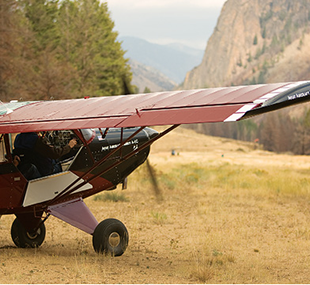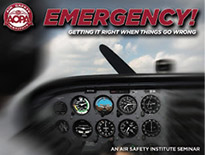Backcountry flying
How do I know I’m covered?
 By Jim Pinegar, AOPA Insurance Services
By Jim Pinegar, AOPA Insurance Services
Q. In regard to backcountry landings, how can I be sure that when I land my Helio or Husky at a remote strip, I am covered?—Gordon
A. Barring any “off-airport” exclusions in your policy—which are very rare these days—landing is landing, and landing is generally covered. Sounds easy, right? Well, there are a few caveats. Coverage is commonly excluded if the pilot intends or expects damage (outside of an emergency); the aircraft is knowingly being used for unlawful purposes; the aircraft is being piloted by someone not approved by the policy; or the aircraft is being used for a purpose other than what the policy covers—i.e., performing a commercial operation on a noncommercial policy. At the end of the day, if you are performing a landing in good faith at a location that a reasonable person would deem appropriate, you’re probably safe in regard to coverage.
Jim Pinegar is vice president and director of AOPA Insurance Services. Have a question? Email [email protected].
SURVEY
78: Percentage of AOPA members who say the cost of insurance is of high importance.

Answers for pilots
Problems with the color vision test?
About 8 percent of men and one-half percent of women are affected by some kind of color vision deficiency. If that is you, although you likely can see color everywhere, you’ve come to find that the colors you see are different than what others see. It’s possible you may fail the color plate test at the time of your FAA flight physical and the AME may limit your certificate, “Not valid for night flying or color signal control.” It may be possible to have the restriction removed by taking one of the FAA-approved alternative color plate tests. Find out more in February’s online Answers for Pilots.
New member named to Board of Trustees
 Luke Wippler has been named the newest member of AOPA’s Board of Trustees. The appointment was made late in 2015, after an exhaustive selection process.
Luke Wippler has been named the newest member of AOPA’s Board of Trustees. The appointment was made late in 2015, after an exhaustive selection process.
Wippler is an avid private pilot based in the Minneapolis area. “As far back as I can remember, it was always about airplanes,” he said. A formal introduction to aviation came from his father-in-law, who owned a floatplane. “I had probably 100 or 200 hours of time in a floatplane before starting with an instructor.”
After earning his private pilot certificate and quickly adding on a tailwheel endorsement and seaplane rating, Wippler bought a few airplanes and started taking longer trips. He and his father-in-law once got stuck in Texas and had to leave the airplane and fly home commercially. “I started my instrument rating the next week,” he said.
Today Wippler owns a Beechcraft Bonanza, and he is looking to upgrade to a Baron. He is a senior vice president at US Bank.
In his service to AOPA, Wippler hopes to help grow the pilot population. “My focus is on youth engagement and building the pipeline. If you look at the member base and the pilot population at large, it’s tough. I want to see that engagement grow.”
Wippler’s appointment brings the board to 11 members after the recent retirements of longtime members Andy Pew and Paul Heintz, both of whom now serve as trustees emeriti.
AOPA FOUNDATION

Safe pilots are always learning, and the AOPA Air Safety Institute’s goal is to ensure that pilots have a wealth of information to keep flying safely. Our aviation safety programs are funded through donations from pilots dedicated to forwarding that mission. Show your support by donating to the AOPA Foundation today.
Air Safety Institute
Trapped on top
Know when it’s time to reach out
Imagine you are an instrument-rated pilot who isn’t current, dealing with an unexpected IFR descent—then add the problem of an engine failure induced by fuel exhaustion. You’re about to lose critical instrumentation that you depend on for spatial orientation in the clouds. How would you cope? Who would you look to for help?
Enter Real Pilot Story: Trapped on Top. The story begins on a beautiful morning at Afton, Wyoming, when Ken Lawson set out in his Mooney on a quest to deliver Christmas gifts to his son and family in North Bend, Washington. But as the flight progresses, low-lying clouds move in, trapping Lawson and his airplane on top and forcing him to fly past his destination—and beyond his alternate—while slowly depleting the fuel tanks in a search for a break in the overcast. When he finally reaches out to air traffic control, it’s almost too late for help.
Like Lawson, some pilots are hesitant to admit their trouble to ATC because they are afraid of potential ramifications, so they resolve to work on the problem by themselves. But that decision can be dangerous, as you will see in this video re-creation of the incident. Luckily, a team of ATC specialists mounted a heroic effort to get him on the ground safely.
Remember that ATC can help. Don’t hide the truth—especially when confessing can save your life.
The three controllers involved received the 2012 Archie League Medal of Safety Award in honor of the most outstanding flight assist of the year.
It’s unwise to fly in ice
Airframe icing will distort the flow of air over the wing, reduce lift, and adversely affect the airplane’s handling characteristics—while significantly increasing drag. Watch ASI’s Pilot Safety Announcement: It’s a Drag as a reminder to avoid weather conditions conducive to airframe icing.
 New ASI Seminar
New ASI Seminar
‘Emergency! Getting it Right when Things Go Wrong’
Get a handle on coping with “up here, wishing you were down there” emergencies. This new seminar is full of expert tips and advice for keeping critical problems under control. Visit the website (www.airsafetyinstitute.org/seminars) for dates and locations near you. Icons identify fly-in or other unique aviation locations.
Member Products
PilotProtection Services
Medication theory, FAA-style
Considering good medications with bad side effects
By Gary Crump, AOPA Senior Medical Specialist
The AOPA Pilot Information Center-Medical Certification gets lots of questions about the use of medications while flying, and for good reason. Pilots need to know how certain medications perform while in a human body that is subjected to altitude changes. In a recent Pilot Protection Services medical webinar, we talked about how the FAA reviews a medication to determine its appropriateness for use during flight activities.
We talked specifically about three new diabetes medications known as sodium glucose co-transporter (SGLT2) inhibitors: dapagliflozin (Farxiga), canagliflozin (Invokana), and empagliflozin (Jardiance). With any new medications, the FAA requires one year of U.S. Food and Drug Administration approval before the drug can be considered for airman medical certification. An FAA committee of physicians will review the literature on these medications to determine whether they can be used safely by pilots and, if so, if any limitations or restrictions are required.
In nondiabetics, glucose is reabsorbed by the kidney’s filtration system, located in the nephrons—the main structural and function components in the kidney. Glucose is routed through the filtration system for reabsorption, to be stored for cellular energy that powers our bodies, while some of the waste products are passed through the filters and excreted in urine.
To retrieve the glucose through filtration, the kidneys have two types of “carrier proteins,” one of which is sodium glucose-linked transporters, that transport both glucose and sodium. For people with Type II diabetes, the filtration process allows excess glucose to be released back into the body, resulting in a state of high blood sugar. The SGLT2 inhibitors reroute the excess glucose so that it’s excreted in urine. Unfortunately, the process also depletes sodium and other essential trace minerals, which can disrupt the balance of the electrolytes that keep our bodies in sync. The chemical mechanism also can result in a higher-than-normal potassium level, and a disruption of potassium can result in heart arrhythmias.
Therein lies the rub for the FAA. The complex process by which these medications work results in a higher risk of side effects that also can lead to urinary tract infections, dehydration, fainting (syncope), constipation, nausea, abdominal pain, and pancreatitis. The FAA continues to review the literature, but it is probably safe to say that these medications are not going to be allowed for flight activities—despite their effectiveness in treating diabetes.
Gary Crump is the senior director of medical certification for AOPA’s Pilot Information Center and a consultant for Pilot Protection Services.


